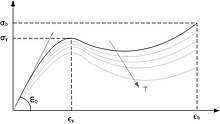Thermoplastic: Difference between revisions
No edit summary |
|||
| Line 139: | Line 139: | ||
*[[Nurdle]] |
*[[Nurdle]] |
||
*[[Emulsion dispersion]] |
*[[Emulsion dispersion]] |
||
* [http://us.mt.com/us/en/home/supportive_content/matchar_apps.MatChar_HB251.titrationEd.html?crel=ePR_wiki_en%20 ABS glass transition by DSC ] |
|||
==References== |
==References== |
||
Revision as of 05:46, 12 January 2012
This article needs additional citations for verification. (October 2009) |
Thermoplastic, also known as a thermosoftening plastic,[1][2] is a polymer that turns to a liquid when heated and freezes to a very glassy state when cooled sufficiently. Most thermoplastics are high-molecular-weight polymers whose chains associate through weak Van der Waals forces (polyethylene); stronger dipole-dipole interactions and hydrogen bonding (nylon);[3] or even stacking of aromatic rings (polystyrene). Thermoplastic polymers differ from thermosetting polymers (Bakelite) in that they can be remelted and remoulded. Many thermoplastic materials are addition polymers; e.g., vinyl chain-growth polymers such as polyethylene and polypropylene.
Theory

Thermoplastics are elastic and flexible above a glass transition temperature Tg, specific for each one—the midpoint of a temperature range in contrast to the sharp melting point of a pure crystalline substance like water. Below a second, higher melting temperature, Tm, also the midpoint of a range, most thermoplastics have crystalline regions alternating with amorphous regions in which the chains approximate random coils. The amorphous regions contribute elasticity and the crystalline regions contribute strength and rigidity, as is also the case for non-thermoplastic fibrous proteins such as silk. (Elasticity does not mean they are particularly stretchy; e.g., nylon rope and fishing line.) Above Tm all crystalline structure disappears and the chains become randomly inter dispersed. As the temperature increases above Tm, viscosity gradually decreases without any distinct phase change.[citation needed]
Some thermoplastics normally do not crystallize: they are termed "amorphous" plastics and are useful at temperatures below the Tg. They are frequently used in applications where clarity is important. Some typical examples of amorphous thermoplastics are PMMA, PS and PC. Generally, amorphous thermoplastics are less chemically resistant and can be subject to environmental stress cracking. Thermoplastics will crystallize to a certain extent and are called "semi-crystalline" for this reason. Typical semi-crystalline thermoplastics are PE, PP, PBT and PET. The speed and extent to which crystallization can occur depends in part on the flexibility of the polymer chain. Semi-crystalline thermoplastics are more resistant to solvents and other chemicals. If the crystallites are larger than the wavelength of light, the thermoplastic is hazy or opaque.[citation needed]
Semi-crystalline thermoplastics become less brittle above 'T'g. If a plastic with otherwise desirable properties has too high a Tg, it can often be lowered by adding a low-molecular-weight plasticizer to the melt before forming (Plastics extrusion; molding) and cooling. A similar result can sometimes be achieved by adding non-reactive side chains to the monomers before polymerization. Both methods make the polymer chains stand off a bit from one another. Before the introduction of plasticizers, plastic automobile parts often cracked in cold winter weather. Another method of lowering Tg (or raising Tm) is to incorporate the original plastic into a copolymer, as with graft copolymers of polystyrene, or into a composite material. Lowering Tg is not the only way to reduce brittleness. Drawing (and similar processes that stretch or orient the molecules) or increasing the length of the polymer chains also decrease brittleness.[citation needed]
Thermoplastics can go through melting/freezing cycles repeatedly and the fact that they can be reshaped upon reheating gives them their name. This quality makes thermoplastics recyclable. The processes required for recycling vary with the thermoplastic. The plastics used for soda bottles are a common example of thermoplastics that can be and are widely recycled. Animal horn, made of the protein α-keratin, softens on heating, is somewhat reshapable, and may be regarded as a natural, quasi-thermoplastic material.[citation needed]
Although modestly vulcanized natural and synthetic rubbers are stretchy, they are elastomeric thermosets, not thermoplastics. Each has its own Tg, and will crack and shatter when cold enough so that the crosslinked polymer chains can no longer move relative to one another. But they have no Tm and will decompose at high temperatures rather than melt. Recently, thermoplastic elastomers have become available.[citation needed]
Terminology
The literature on thermoplastics is huge, and can be quite confusing, as the same chemical can be available in many different forms (for example, at different molecular weights), which might have quite different physical properties. The same chemical can be referred to by many different tradenames, by different abbreviations; two chemical compounds can share the same name; a good example of the latter is the word "Teflon" which is used to refer to a specific polymer (PTFE); to related polymers such as PFA, and generically to fluoropolymers.[citation needed]
Testing
Testing of thermoplastics can take various forms.
Tensile tests—ISO 527 -1/-2 and ASTM D 638 set out the standardized test methods. These standards are technically equivalent. However they are not fully comparable because of the difference in testing speeds. The modulus determination requires a high accuracy of ± 1 micrometer for the dilatometer.
Flexural tests—3-points flexural tests are among the most common and classic methods for semi rigid and rigid plastics.
Pendulum impact tests—impact tests are used to measure the behavior of materials at higher deformation speeds. Pendulum impact testers are used to determine the energy required to break a standardized specimen by measuring the height to which the pendulum hammer rises after impacting the test piece.
See also
References
- ^ http://www.lgschemistry.org.uk/PDF/Thermosoftening_and_thermosetting_plastics.pdf
- ^ Baeurle SA, Hotta A, Gusev AA (2006). "On the glassy state of multiphase and pure polymer materials". Polymer. 47: 6243–6253. doi:10.1016/j.polymer.2006.05.076.
{{cite journal}}: CS1 maint: multiple names: authors list (link) - ^ Karimi-Varzaneh HA, Carbone P, Mueller-Plathe F (2008). "Hydrogen Bonding and Dynamic Crossover in Polyamide-66: A Molecular Dynamics Simulation Study". Macromolecules. 41: 7211–7218. doi:10.1021/ma8010685.
{{cite journal}}: CS1 maint: multiple names: authors list (link)
